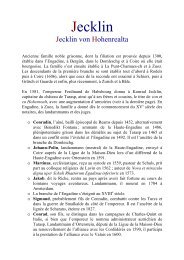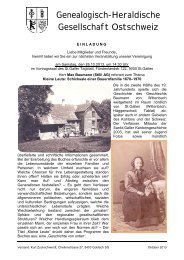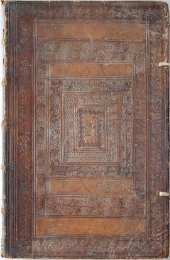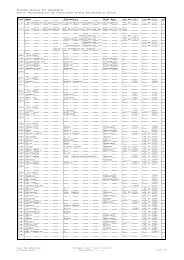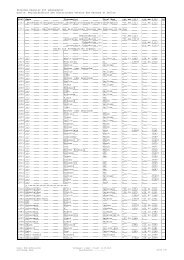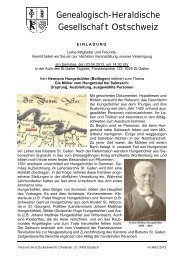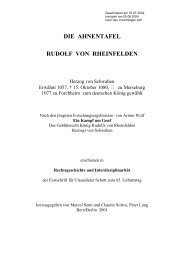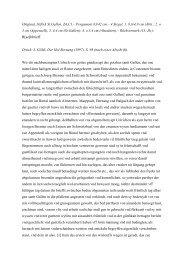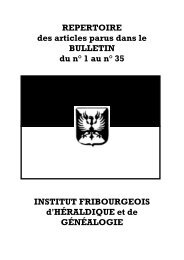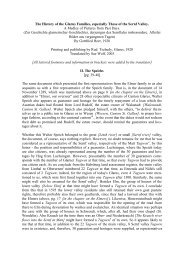The History of the Citizen Families of Engi and their Development ...
The History of the Citizen Families of Engi and their Development ...
The History of the Citizen Families of Engi and their Development ...
Create successful ePaper yourself
Turn your PDF publications into a flip-book with our unique Google optimized e-Paper software.
<strong>The</strong> <strong>History</strong> <strong>of</strong> <strong>the</strong> <strong>Citizen</strong> <strong>Families</strong> <strong>of</strong> <strong>Engi</strong> <strong>and</strong> <strong>the</strong>ir <strong>Development</strong><br />
[Zur Geschichte der bürgerlichen Geschlechter von <strong>Engi</strong> und ihre Entwicklung]<br />
Public lectures by Martin Baumgartner, teacher in <strong>Engi</strong>.<br />
Self-published by <strong>the</strong> author, Glarner News print shop, Rud. Tschudy, 1923.<br />
Translated by Sue Wolf<br />
[All lettered footnotes <strong>and</strong> information in brackets were added by <strong>the</strong> translator]<br />
IV. <strong>The</strong> Hämmerli Family<br />
[pg. 33-41]<br />
We have been able to trace <strong>the</strong> three families we have spoken <strong>of</strong> up to now, <strong>the</strong> Martis, Blumers<br />
<strong>and</strong> Baumgartners, back to an ancestor, but that is not possible now with <strong>the</strong> Hämmerlis from<br />
<strong>Engi</strong>. In <strong>the</strong> year 1595, when <strong>the</strong> church books were begun, a goodly number <strong>of</strong> Hämmerlis were<br />
already settled in <strong>Engi</strong>, since in this year no fewer than 16 baptisms were recorded from <strong>the</strong><br />
Hämmerli family, more than by most <strong>of</strong> <strong>the</strong> present larger families. In 1566 a Lienhard<br />
Hämmerli from <strong>the</strong> Uznachberg [Canton St. Gallen] bought himself <strong>the</strong> Glarner cantonal rights<br />
for 40 Gulden. We are not able to establish whe<strong>the</strong>r that was <strong>the</strong> only Hämmerli in <strong>Engi</strong> <strong>and</strong>,<br />
consequently, <strong>the</strong> ancestor, or what is more likely, whe<strong>the</strong>r more Hämmerlis moved into <strong>Engi</strong><br />
toge<strong>the</strong>r from Utznach, <strong>of</strong> one <strong>of</strong> <strong>the</strong> two faiths, between 1530 <strong>and</strong> 1550. <strong>The</strong>re were, <strong>of</strong> course,<br />
also Hämmerlis in <strong>Engi</strong> who, until 1834, belonged to <strong>the</strong> non-cantonal citizens but, never<strong>the</strong>less,<br />
acquired <strong>the</strong> Tagwen a rights <strong>of</strong> <strong>Engi</strong> for <strong>the</strong>mselves, that is, <strong>the</strong> Hämmerlis as well as <strong>the</strong> Bräms<br />
in <strong>Engi</strong> were all Tagwen associates. We will learn later that in <strong>the</strong> year 1822 <strong>the</strong>se rights were<br />
refused to <strong>the</strong>m, that is, to some Hämmerli <strong>and</strong> Bräm families.<br />
In <strong>the</strong> old Tagwen records only one Hämmerli Tagwen rights purchase exists, namely that <strong>of</strong><br />
Gallus Hämmerli (Nr. 13 in <strong>the</strong> family tree), born in 1599, died in 1673, who bought, however,<br />
only for himself. <strong>The</strong> extract from <strong>the</strong> old Tagwen book reads as follows:<br />
"On Our Lady's Day in March [March 8 th ] <strong>of</strong> <strong>the</strong> year 1651, thus <strong>the</strong> communal Tagwen citizens<br />
in <strong>Engi</strong> had accepted <strong>the</strong> same Gallus Hämmerli as a Tagwen citizen, accordingly <strong>and</strong> <strong>of</strong> <strong>the</strong> kind<br />
that he be allowed to use <strong>and</strong> make use <strong>of</strong> <strong>the</strong> Tagwen rights in <strong>the</strong> same situation as any o<strong>the</strong>r<br />
Tagwen citizen, <strong>and</strong> that his life be long <strong>and</strong> enduring. When he, however, dies <strong>and</strong> his wife has<br />
survived, so may she herself use <strong>and</strong> make use <strong>of</strong> <strong>the</strong>m for her long life, as long as she remain<br />
unchanging (a widow). But if she changes [remarries], <strong>the</strong>n she gives up <strong>the</strong>se Tagwen rights<br />
completely <strong>and</strong> above all. Also that no title to <strong>the</strong> Tagwen rights <strong>of</strong> <strong>the</strong>ir parents shall convey to<br />
ei<strong>the</strong>r <strong>the</strong>ir children or descendants, over a brief time or always, because <strong>of</strong> not yet seeking [<strong>the</strong>ir<br />
own rights], but it [<strong>the</strong> title] shall end with <strong>the</strong> above-mentioned persons. He had, <strong>the</strong>refore,<br />
given 50 Gulden <strong>and</strong> 10 measures <strong>of</strong> wine." (=15 liters; 1 measure = 1 ½ liters.)<br />
This Gallus Hämmerli had married two wives: in 1618, Doro<strong>the</strong>a Britt from Kerenzen (who died<br />
in 1662) <strong>and</strong> in 1664, Margreth Luchsinger from Schw<strong>and</strong>en. From <strong>the</strong> first marriage he had 7<br />
children, but none <strong>of</strong> <strong>the</strong>m grew older than 10 years. In 1651, on <strong>the</strong> occasion <strong>of</strong> his Tagwen<br />
rights purchase, he possessed no more children. Five <strong>of</strong> <strong>the</strong>m died in 1629 <strong>of</strong> <strong>the</strong> plague, a little<br />
girl drowned in <strong>the</strong> Sernf [river], <strong>and</strong> a little son died at three months old. His second marriage<br />
was childless, underst<strong>and</strong>ably, since at <strong>the</strong> time <strong>of</strong> <strong>the</strong> marriage <strong>the</strong> bride was 49 years old <strong>and</strong><br />
<strong>the</strong> groom 65.<br />
Although in <strong>the</strong> year 1595, <strong>the</strong>refore, several Hämmerli families existed in <strong>Engi</strong>, never<strong>the</strong>less all<br />
<strong>of</strong> <strong>the</strong> Hämmerlis from <strong>Engi</strong> can now be traced back to only 2 ancestors. All o<strong>the</strong>r Hämmerlis <strong>of</strong>
that time (it was 6 families) probably, to some extent, had several children (as, for example, <strong>the</strong><br />
Gallus Hämmerli who was mentioned), but no head <strong>of</strong> family who fur<strong>the</strong>red <strong>the</strong> family tree. That<br />
was a primary reason why <strong>the</strong> Hämmerlis developed slowly <strong>and</strong> not very well at first, in relation<br />
to <strong>the</strong> families spoken <strong>of</strong> up to now.<br />
Whe<strong>the</strong>r both <strong>the</strong> ancestors <strong>of</strong> today's Hämmerlis were first cousins (<strong>the</strong>y were determined to not<br />
be bro<strong>the</strong>rs), or still more distantly related, that cannot be dealt with. <strong>The</strong> one was Baschli<br />
Hämmerli (Nr. 4), recorded thus instead <strong>of</strong> as Sebastian, married to Anna Marti. He had 3<br />
children, a daughter, who died in 1629 <strong>of</strong> <strong>the</strong> plague at <strong>the</strong> age <strong>of</strong> 28, <strong>and</strong> 2 sons, Jakob <strong>and</strong> Jost,<br />
both heads <strong>of</strong> families with fairly extensive descendants. (<strong>The</strong> latter died <strong>of</strong> <strong>the</strong> plague in <strong>the</strong><br />
year 1629, <strong>and</strong> also his first wife <strong>and</strong> 4 children). <strong>The</strong> o<strong>the</strong>r head <strong>of</strong> family was Hans Hämmerli<br />
(Nr. 7), who died in 1650, <strong>the</strong> son <strong>of</strong> Lienhard who had purchased [<strong>the</strong> Glarner cantonal rights]<br />
for himself in 1566. Married to a Doro<strong>the</strong>a Dietrich, he possessed 6 children, 2 <strong>of</strong> <strong>the</strong>m heads <strong>of</strong><br />
families, Leonhard (Nr. 16) <strong>and</strong> Hans (Nr. 15). However, <strong>the</strong> family <strong>of</strong> <strong>the</strong> latter became extinct<br />
already with his gr<strong>and</strong>son, Tagwen <strong>of</strong>ficial Fridolin Hämmerli (Nr. 29), 1648-1710, since his<br />
only son, Hans, died unmarried at <strong>the</strong> age <strong>of</strong> 20. From Leonhard, on <strong>the</strong> contrary, were<br />
descended, among o<strong>the</strong>rs, <strong>the</strong> following families <strong>of</strong> today: that <strong>of</strong> old Johannes Hämmerli,<br />
proprietor <strong>of</strong> <strong>the</strong> Schäfli hotel, <strong>and</strong> his 2 older bro<strong>the</strong>rs, <strong>and</strong> that <strong>of</strong> old master weaver Jakob<br />
Hämmerli <strong>and</strong> his 4 older bro<strong>the</strong>rs. <strong>The</strong>se were <strong>the</strong> only families who were descendants <strong>of</strong> <strong>the</strong><br />
Leinhard Hämmerli who was admitted into <strong>the</strong> cantonal rights in 1566.<br />
It may possibly be known to you that, until <strong>the</strong> year 1836, a portion <strong>of</strong> <strong>the</strong> Hämmerlis <strong>and</strong> <strong>the</strong><br />
Bräms in <strong>Engi</strong> were only so-called new cantonal people, that is, <strong>the</strong>y possessed only <strong>the</strong> Tagwen<br />
rights from <strong>Engi</strong>, but belonged to <strong>the</strong> so-called non-cantonal citizens, since <strong>the</strong>y did not possess<br />
<strong>the</strong> Glarner cantonal rights. For <strong>the</strong> first time in 1836, owing to <strong>the</strong> L<strong>and</strong>sgemeinde b decision <strong>of</strong><br />
1834, all <strong>the</strong>se non-cantonal citizens, whose forefa<strong>the</strong>rs by this time had lived for centuries in <strong>the</strong><br />
canton <strong>and</strong> possessed <strong>the</strong> Tagwen rights <strong>of</strong> a commune, were granted <strong>the</strong> cantonal rights<br />
immediately, in exchange for a relatively small purchase sum. In total, 54 Hämmerlis <strong>and</strong> 12<br />
Bräms from <strong>Engi</strong> belonged <strong>the</strong>n to that group. Among <strong>the</strong> Hämmerlis are <strong>the</strong>n, quite certainly,<br />
all <strong>the</strong> descendants <strong>of</strong> <strong>the</strong> first-named <strong>of</strong> <strong>the</strong> 2 heads <strong>of</strong> families: Baschli Hämmerli. <strong>The</strong> fa<strong>the</strong>r <strong>of</strong><br />
<strong>the</strong> o<strong>the</strong>r heads <strong>of</strong> families had, <strong>of</strong> course, as was already noted, acquired <strong>the</strong> Glarner cantonal<br />
rights in <strong>the</strong> year 1566 for 40 Gulden, <strong>and</strong> his descendants have always been cantonal citizens, in<br />
contrast to those <strong>of</strong> o<strong>the</strong>r families. <strong>The</strong>n, <strong>the</strong> following Hämmerli branches belonged to <strong>the</strong> noncantonal<br />
citizens who were admitted as citizens for <strong>the</strong> first time in 1836:<br />
1. <strong>The</strong> family <strong>of</strong> old Heinrich Hämmerli in Rüti <strong>and</strong> Johannes Hämmerli in <strong>Engi</strong> <strong>and</strong> his<br />
bro<strong>the</strong>r.<br />
2. <strong>The</strong> family <strong>of</strong> weaver Fridolin Hämmerli, 1804-1869 (fa<strong>the</strong>r <strong>of</strong> 9 daughters), fa<strong>the</strong>r-in-law <strong>of</strong><br />
old Meinrad Marti, cooper, <strong>and</strong> Jakob Marti, from Knie.<br />
3. <strong>The</strong> Hämmerli family from Kummenberg.<br />
4. <strong>The</strong> Josef Hämmerli family, from Höftigen.<br />
5. <strong>The</strong> Niederurnen Hämmerlis.<br />
6. <strong>The</strong> family <strong>of</strong> Jakob Hämmerli, <strong>the</strong> gr<strong>and</strong>fa<strong>the</strong>r <strong>of</strong> cooper Oswald.<br />
7. <strong>The</strong> Samuel Hämmerli family, from Kleingädli.<br />
8. <strong>The</strong> family <strong>of</strong> old Josef Hämmerli, from Spicher.<br />
9. <strong>The</strong> family <strong>of</strong> Sergeant Bernhard Hämmerli, <strong>and</strong> <strong>of</strong> his bro<strong>the</strong>r Josef.<br />
<strong>The</strong>n, in <strong>the</strong> year 1822, even <strong>the</strong> church rights <strong>of</strong> <strong>the</strong>se Hämmerlis <strong>and</strong> Bräms who were not in<br />
possession <strong>of</strong> <strong>the</strong> cantonal rights were disputed on <strong>the</strong> part <strong>of</strong> <strong>the</strong> church commune, that is, that<br />
<strong>the</strong>y had had <strong>the</strong> use <strong>of</strong> <strong>the</strong>se rights until <strong>the</strong>n in an unlawful way. For, according to <strong>the</strong> church's<br />
judgement <strong>of</strong> 1710, on <strong>the</strong> occasion <strong>of</strong> a Tagwen rights purchase <strong>the</strong>y had to have paid 30<br />
Gulden to <strong>the</strong> church for <strong>the</strong> purchase <strong>of</strong> <strong>the</strong> church rights. That was never yet done by <strong>the</strong>m.
This matter only came before <strong>the</strong> bar <strong>of</strong> <strong>the</strong> high council in 1822. Appearing in <strong>the</strong> name <strong>of</strong> <strong>the</strong><br />
church commune were Federal councillor Jakob Marti from <strong>Engi</strong>, Federal councillor Peter<br />
Wohlwend from Matt <strong>and</strong> Tagwen <strong>of</strong>ficial Dietrich Stauffacher from Matt. Coming forward in<br />
<strong>the</strong> name <strong>of</strong> <strong>the</strong> Hämmerli <strong>and</strong> Bräm small farmers, as "rejects", were Jost Hämmerli<br />
(gr<strong>and</strong>fa<strong>the</strong>r <strong>of</strong> old Kummenberg Heinrich) <strong>and</strong> his three sons, Fridolin, Jost <strong>and</strong> Heinrich. A<br />
great number <strong>of</strong> his descendants live today in <strong>the</strong> Toggenberg [Canton St. Gallen]. <strong>The</strong>y pointed<br />
out that <strong>the</strong> Hämmerli <strong>and</strong> Bräm families had used <strong>and</strong> enjoyed <strong>the</strong> Tagwen <strong>and</strong> church rights<br />
unhindered already for more than 200 years, that <strong>the</strong>y all (<strong>the</strong>refore, <strong>the</strong> Hämmerlis in question)<br />
were descended from Sebastian Hämmerli, who, according to <strong>the</strong> council's judgement <strong>of</strong> 1605,<br />
was recognized as a Tagwen citizen from <strong>Engi</strong>, <strong>and</strong> that <strong>the</strong> those concerned were admitted into<br />
<strong>the</strong> 1763 church alpine register, as well as into <strong>the</strong> charity <strong>and</strong> Gulden registers, <strong>and</strong>,<br />
consequently, had carried <strong>the</strong> burden <strong>and</strong> weight just like <strong>the</strong> rest <strong>of</strong> <strong>the</strong> church members. Also<br />
that <strong>the</strong> bro<strong>the</strong>r <strong>of</strong> <strong>the</strong> complainant Jost Hämmerli, <strong>the</strong> school master Heinrich Hämmerli, was<br />
charity master <strong>of</strong> <strong>the</strong> Matt-<strong>Engi</strong> church commune, <strong>and</strong> so forth.<br />
<strong>The</strong> council <strong>the</strong>n came to <strong>the</strong> following decision <strong>and</strong> judgement: <strong>the</strong> rejects <strong>of</strong> <strong>the</strong> church<br />
commune were dismissed in <strong>the</strong>ir request, mainly for <strong>the</strong> reason that even before 1710 <strong>the</strong> Matt<br />
<strong>and</strong> <strong>Engi</strong> Tagwens were a joint Tagwen, <strong>and</strong> church as well as Tagwen must have existed in <strong>the</strong><br />
same association. So, with a Tagwen rights purchase before 1710, <strong>the</strong> church rights were also<br />
included with it. For <strong>the</strong> first time, after <strong>the</strong> separation <strong>of</strong> <strong>the</strong> Tagwens in <strong>the</strong> year 1710, it was<br />
determined that <strong>the</strong> church rights also must be purchased along with <strong>the</strong> Tagwen rights, for 30<br />
Gulden extra. <strong>The</strong> so-called small farmers, however, had, <strong>of</strong> course, as already stressed, been<br />
regarded as Tagwen citizens already in 1605. (<strong>The</strong> purchase must, <strong>the</strong>refore, have occurred<br />
previously <strong>and</strong> was not found even in <strong>the</strong> Tagwen books, since <strong>the</strong>se began for <strong>the</strong> first time<br />
around 1620.)<br />
This council decision exists still in <strong>the</strong> original in <strong>the</strong> possession <strong>of</strong> Captain Hämmerli (who died<br />
in 1923).<br />
A reason for <strong>the</strong> very moderate development <strong>of</strong> <strong>the</strong> Hämmerlis is also <strong>the</strong> fact that <strong>the</strong> plague in<br />
<strong>the</strong> year 1629 affected <strong>the</strong> Hämmerlis especially hard. <strong>The</strong>re were no fewer than 14 persons,<br />
mostly children, from this family who fell victim to it, <strong>of</strong> <strong>the</strong>m 5 sons who could also have<br />
become heads <strong>of</strong> families. So <strong>the</strong>re were 28 families to report in <strong>the</strong>ir family tree until 1700, 44<br />
until 1750, <strong>and</strong>, for <strong>the</strong> first time, 64 in 1800 (<strong>the</strong> Baumgartners had 12 in 1700, <strong>and</strong> 77 in 1800).<br />
<strong>The</strong>y numbered 104 until 1850 (<strong>the</strong> Baumgartners had 154), 150 in 1880 (<strong>the</strong> Baumgartners had<br />
220), 178 in 1900, <strong>and</strong> 210 now. With <strong>the</strong> same, more vigorous, development as <strong>the</strong> 3 families<br />
already dealt with, <strong>the</strong>y would have numbered at least twice as many families. As we can see<br />
from <strong>the</strong> statistics, <strong>the</strong> fact might also have contributed besides that only 49% <strong>of</strong> <strong>the</strong> Hämmerli<br />
children were sons, but with <strong>the</strong> Baumgartners, for example, <strong>the</strong>re were 54% (<strong>the</strong> Gigers had <strong>the</strong><br />
least, with 47%), <strong>and</strong> generally, on <strong>the</strong> average, a small number <strong>of</strong> children was produced, as<br />
<strong>the</strong>re were 4.6 children per family, but with <strong>the</strong> Baumgartners 5.4, as we have emphasized<br />
before.<br />
Of <strong>the</strong> Hämmerlis only 340 persons = 29% have emigrated; <strong>of</strong> <strong>the</strong>m, 23% emigrated to North<br />
America, 4% to Brazil, 26% to o<strong>the</strong>r cantons (mainly into <strong>the</strong> Toggenberg) <strong>and</strong> 34% to o<strong>the</strong>r<br />
communes (above all, Niederurnen <strong>and</strong> Glarus). <strong>The</strong> Hämmerlis thus, concluding from <strong>the</strong><br />
statistics, have remained <strong>the</strong> most faithful to our commune, next to <strong>the</strong> Giger family. Hence, it<br />
explains also that today <strong>the</strong> Hämmerlis are reported on with 45 enjoying <strong>the</strong> benefits <strong>of</strong> <strong>the</strong><br />
Tagwen rights, whereas <strong>the</strong> much larger family <strong>of</strong> <strong>the</strong> Blumers has only 38.<br />
<strong>The</strong>ir relatively modest emigration is also a reason that, <strong>of</strong> all <strong>the</strong>ir wives, 52% stemmed from<br />
<strong>Engi</strong>. Consequently, <strong>the</strong> most numerous marriages in our citizen families were produced. <strong>The</strong>y
were distributed among <strong>the</strong>se as follows: <strong>the</strong> Martis 32 = 25%, <strong>the</strong> Blumers 21 = 17%, <strong>the</strong><br />
Baumgartners <strong>and</strong> Hämmerlis each 19 = 15%, <strong>the</strong> Luchsingers 13 = 10%, <strong>the</strong> Altmanns 6 =<br />
4.9%, <strong>the</strong> Wysses <strong>and</strong> Bräms each 5 = 4%, <strong>and</strong> <strong>the</strong> Gigers <strong>and</strong> Norders each 1.<br />
<strong>The</strong> inheritance <strong>of</strong> forenames with <strong>the</strong> Hämmerlis st<strong>and</strong>s out significantly <strong>and</strong> distinctly. Above<br />
all, 29 = 14% <strong>of</strong> <strong>the</strong>ir heads <strong>of</strong> families carry <strong>the</strong> name Leonhard, 28 = 13.5% Fridolin, 23 =<br />
11% Hans or Johannes, 18 = 8% Jakob <strong>and</strong> Heinrich, 14 = 6.7% Jost, <strong>and</strong> 12 = 5.75% Josef <strong>and</strong><br />
Samuel. Those are <strong>the</strong> most frequent Hämmerli names.<br />
<strong>The</strong> <strong>of</strong>fices <strong>the</strong>y have held present an insignificant topic with <strong>the</strong> Hämmerlis, because, since<br />
even a greater portion <strong>of</strong> <strong>the</strong>m were small farmers, <strong>the</strong>y remained unconsidered at <strong>the</strong> filling <strong>of</strong><br />
<strong>of</strong>fices, <strong>and</strong> for <strong>the</strong> first time, since <strong>the</strong> 30's <strong>of</strong> <strong>the</strong> last century, with <strong>the</strong>ir final purchase into <strong>the</strong><br />
Glarner cantonal rights, <strong>the</strong>y are increasing considerably in <strong>the</strong>ir reputation.<br />
Of federal councillors, <strong>the</strong> Hämmerlis provided only one, <strong>and</strong> that one was living in Matt<br />
besides. That referred to Federal Councillor <strong>and</strong> Tagwen <strong>of</strong>ficial Fridolin, born ?, died in 1646<br />
(Nr. 3). We can almost definitely admit that he was a son <strong>of</strong> <strong>the</strong> Lienhard who received <strong>the</strong><br />
cantonal rights in 1566, since <strong>of</strong> his 2 sons he called <strong>the</strong> older one Leonhard, born in 1603, <strong>and</strong><br />
<strong>the</strong> o<strong>the</strong>r one Jakob, born in 1610. <strong>The</strong> fate <strong>of</strong> both sons is unknown; <strong>the</strong>y very probably fell<br />
victim to <strong>the</strong> plague in <strong>the</strong> year 1629, in <strong>the</strong> time when no pastor served in Matt <strong>and</strong>, <strong>the</strong>refore,<br />
also no entries were made in <strong>the</strong> church books. Of Tagwen <strong>of</strong>ficials <strong>of</strong> older significance, <strong>the</strong><br />
Hämmerlis provided 4, <strong>the</strong>n a church steward, an inspector <strong>of</strong> weights <strong>and</strong> measures <strong>and</strong> a<br />
charity <strong>of</strong>ficial. In <strong>the</strong> old military <strong>the</strong>y were represented by a lieutenant <strong>and</strong> 3 sergeants.<br />
<strong>The</strong> first 2 <strong>Engi</strong> schoolmasters were Hämmerlis. We have, indeed, already mentioned that <strong>Engi</strong><br />
possessed its own school just since 1779, <strong>and</strong>, to be sure, only as a very primitive schoolroom, as<br />
it reports in a 1780 statement: "our local school is only a room attached to ano<strong>the</strong>r building." We<br />
are, indeed, most familiar with where to find this former school; it is <strong>the</strong> residence <strong>of</strong> Jost<br />
Altmann on <strong>the</strong> little Rigi alley which served as schoolroom from 1779 until 1832. - <strong>The</strong>re <strong>the</strong>n<br />
served <strong>the</strong> first schoolmaster, Heinrich Hämmerli, born in 1741, died in 1815, from 1779-1805<br />
with a year's salary <strong>of</strong> 20-25 Gulden. Of course, he held only 18 weeks <strong>of</strong> school every year. He<br />
was a bro<strong>the</strong>r <strong>of</strong> <strong>the</strong> aforementioned Jost Hämmerli who appeared before <strong>the</strong> council in 1822 in<br />
<strong>the</strong> name <strong>of</strong> <strong>the</strong> small farmers. Besides, he also occupied <strong>the</strong> <strong>of</strong>fice <strong>of</strong> a charity <strong>of</strong>ficial <strong>and</strong><br />
directed <strong>the</strong> so-called singing school. Married to Anna Wyss from <strong>Engi</strong> (1739-1813), his<br />
marriage remained childless. His personal accomplishments in reading, writing <strong>and</strong> arithmetic<br />
must, however, still have been pretty modest. Around <strong>the</strong> year 1800, in <strong>the</strong> time <strong>of</strong> <strong>the</strong> Helvetic<br />
Republic, as <strong>the</strong> high-minded minister Stapfer was endeavoring to lead <strong>the</strong> educational system<br />
towards better methods, <strong>the</strong> schoolmasters at <strong>the</strong> time <strong>of</strong> all <strong>the</strong> communes composed a report<br />
about <strong>the</strong> condition <strong>of</strong> <strong>the</strong>ir schools <strong>and</strong> replied to a questionnaire. This work was ra<strong>the</strong>r hard for<br />
Mr. Hämmerli, just as it was, after all, for most <strong>of</strong> <strong>the</strong> schoolteachers at <strong>the</strong> time. He asked <strong>the</strong><br />
pastor in Matt first <strong>of</strong> all for advice. His comments in this report read as follows:<br />
"<strong>The</strong> village <strong>of</strong> <strong>Engi</strong> is so very scattered that it would be very difficult to answer <strong>the</strong> questions<br />
exactly as <strong>the</strong>y are asked, since it is, <strong>the</strong>refore, impossible to tell, thus I will answer <strong>the</strong> above<br />
questions as much as possible in brief. "And at <strong>the</strong> end: "Since I am also allowed weaknesses to<br />
make some comments, thus will I, never<strong>the</strong>less, take <strong>the</strong> occasion to be <strong>of</strong> use. Our village is<br />
very populated, so that hardly <strong>the</strong> half part attend <strong>the</strong> local school. <strong>The</strong> reasons are from this,<br />
however, because it is a very poor <strong>and</strong> needy commune." 1<br />
His successor was again a Hämmerli, but from <strong>the</strong> o<strong>the</strong>r branch, which possessed <strong>the</strong> cantonal<br />
rights. This one was Leonhard Hämmerli, born in 1770, died in 1835 (Nr. 65). Married to<br />
Eufemia Marti, daughter <strong>of</strong> Federal Councillor Johannes Marti from <strong>Engi</strong>, he possessed only a
daughter, Anna, who married Tagwen <strong>of</strong>ficial Josef Blumer <strong>and</strong> migrated into <strong>the</strong> Toggenberg<br />
with him <strong>and</strong> his whole family. Schoolmaster Leonhard Hämmerli was, in addition to church<br />
steward, also a lieutenant, <strong>and</strong>, <strong>of</strong> course, he served as such in <strong>the</strong> foreign regiment <strong>of</strong> Salis-<br />
Marschlin from 1798-1801, <strong>and</strong> thus occupied an respected military position.<br />
From 1805-1833 he <strong>the</strong>n worked in our commune as teacher. Naturally also without any broader<br />
basic education, he, however, must have produced far better results than his predecessor, in spite<br />
<strong>of</strong> it. In a report <strong>of</strong> his activities by Pastor Johann Melchior Schuler, <strong>the</strong> noted history writer who<br />
also worked as school inspector, it said: "To me <strong>Engi</strong> is an admitted example <strong>of</strong> how, owing to a<br />
imaginative, effective schoolmaster <strong>and</strong> by means <strong>of</strong> administrators who promotes <strong>the</strong> better<br />
way, <strong>the</strong> morale <strong>of</strong> a commune improves, <strong>and</strong>, where <strong>the</strong>re was previously antipathy towards<br />
improvement, now a disposition for it is planted. - <strong>The</strong> pastor <strong>and</strong>, equally, <strong>the</strong> administrators<br />
visit <strong>the</strong> school diligently; also <strong>the</strong> administrators are very much in favor <strong>of</strong> improvement in <strong>the</strong><br />
school conduct <strong>and</strong> expect guidance from <strong>the</strong> education council. - It is also reported that, in<br />
contrast to his predecessor, who held school only 18 weeks <strong>of</strong> <strong>the</strong> year but also only received 25<br />
Gulden salary for it, he now held school <strong>the</strong> whole year through <strong>and</strong> for it had hopes <strong>of</strong> "42<br />
Gulden <strong>and</strong> an undetermined donation". - He also already followed <strong>the</strong> Pestalozzi method,<br />
especially in <strong>the</strong> aim <strong>of</strong> building <strong>the</strong> intellect”.<br />
<strong>The</strong> new, yet today old, schoolhouse was built, in addition, with his same efficiency, that is, in<br />
<strong>the</strong> year 1832 for around 1350 Gulden. <strong>The</strong> free supply <strong>of</strong> wood by <strong>the</strong> Tagwen <strong>and</strong> <strong>the</strong> joyful<br />
work <strong>of</strong> <strong>the</strong> citizens were not computed into that. This building being erected was <strong>of</strong> importance<br />
relative to <strong>the</strong> poor communal people <strong>of</strong> that time, <strong>and</strong> compared with <strong>the</strong> old, confining local<br />
school, an achievement as well as a credit to <strong>the</strong> Tagwen. It was really <strong>the</strong> work <strong>of</strong> Pastor Jakob<br />
Heer, who collected no less than 950 Gulden for <strong>the</strong> building by begging <strong>and</strong> untiringly risked<br />
his entire energy.<br />
<strong>The</strong> dignitaries in <strong>of</strong>fices since 1850 from <strong>the</strong> Hämmerli family show <strong>the</strong> following numbers: a<br />
church president, an orphan <strong>of</strong>ficial, a communal councillor, a church councillor, 2 school<br />
administrators, 2 school councillors, 3 mediators <strong>and</strong> a communal secretary.<br />
Seven Hämmerlis perished in foreign military services, that is, <strong>the</strong> following:<br />
In February, 1638, in <strong>the</strong> French service, Hans Hämmerli, born in 1607, single, gr<strong>and</strong>son<br />
<strong>of</strong> <strong>the</strong> Sebastian who was an ancestor.<br />
On 22 December 1743, Hans Hämmerli, born in 1716, single, at Mons [Belgium] in <strong>the</strong><br />
Dutch service under company captain Marti, in <strong>the</strong> Salis Regiment. He was a bro<strong>the</strong>r <strong>of</strong> <strong>the</strong><br />
above-mentioned schoolmaster, Leonhard Hämmerli.<br />
In 1745, in Brabant [Ne<strong>the</strong>rl<strong>and</strong>s], Jost Hämmerli, born in 1706, single, <strong>and</strong><br />
In 1746, his bro<strong>the</strong>r, Jakob Hämmerli, born in 1706, single, as a prisoner <strong>of</strong> war in <strong>the</strong><br />
Dutch service under <strong>the</strong> Planta Army Regiment. <strong>The</strong>y belonged to <strong>the</strong> small farmers' branch.<br />
On 31 October 1781, Josef Hämmerli, born in 1752, single, at Leiden [Ne<strong>the</strong>rl<strong>and</strong>s] in<br />
<strong>the</strong> Dutch service under First Lieutenant Weiss from Glarus. Descendants from <strong>the</strong> family <strong>of</strong> his<br />
fa<strong>the</strong>r no longer exist.<br />
On 9 August 1809, Johann Jakob Hämmerli, born in 1782, single, in <strong>the</strong> military hospital<br />
in Naples on <strong>the</strong> Fieber. He was a soldier in <strong>the</strong> 1 st Swiss Regiment. From his fa<strong>the</strong>r, likewise,<br />
male descendants no longer exist.<br />
On 20 April 1810, Joachim Hämmerli, born in 1789, a bro<strong>the</strong>r <strong>of</strong> <strong>the</strong> fa<strong>the</strong>r <strong>of</strong> old<br />
Johannes, who was proprietor <strong>of</strong> "<strong>The</strong> Schäfli", <strong>and</strong> his bro<strong>the</strong>rs <strong>and</strong> sisters, set out as an enlisted<br />
soldier <strong>and</strong> remains missing. He died presumably under Napoleon in Russia in <strong>the</strong> year 1812. His<br />
bro<strong>the</strong>r, Fridolin Hämmerli, had also enlisted, but he probably was able to get away in some<br />
manner. He died in 1848, single, in <strong>Engi</strong>.
Something more about accidents <strong>and</strong> events which affected <strong>the</strong> Hämmerli family.<br />
On 28 January 1751, S<strong>of</strong>ia Hämmerli, born in 1702, daughter <strong>of</strong> young Jakob Hämmerli in<br />
Schlatt, from whom no more descendants exist, was found dead in bed in <strong>the</strong> morning, along<br />
with her unmarried son, Jakob Wild. <strong>The</strong>y suffocated on <strong>the</strong> smoke <strong>of</strong> <strong>the</strong> stove. This S<strong>of</strong>ia<br />
Hämmerli had two unmarried children:<br />
1. Jakob Wild, born in 1734, who suffocated with her. His fa<strong>the</strong>r was Jost Wild from<br />
Schw<strong>and</strong>en, who had run away.<br />
2. Maria Katharina Tschudi <strong>and</strong> Oertli, a little girl, born in 1738 <strong>and</strong> died in 1740. This<br />
child was acknowledged by two fa<strong>the</strong>rs: 1. <strong>the</strong> titled l<strong>and</strong>owner, Hans Peter Tschudi from<br />
Glarus, <strong>and</strong> 2. Josua Oertli from Ennetbühls.<br />
On 6 September 1807, Sergeant <strong>and</strong> Tagwen <strong>of</strong>ficial Johannes Hämmerli, born in 1768 (Nr. 62),<br />
husb<strong>and</strong> <strong>of</strong> Anna Baumgartner, fell to his death in <strong>the</strong> wild hay. He was <strong>the</strong> gr<strong>and</strong>fa<strong>the</strong>r <strong>of</strong> old<br />
proprietor <strong>of</strong> "<strong>The</strong> Schäfli" Johannes <strong>and</strong> his bro<strong>the</strong>rs <strong>and</strong> sisters, <strong>and</strong> also great-gr<strong>and</strong>fa<strong>the</strong>r on<br />
<strong>the</strong> mo<strong>the</strong>r's side <strong>of</strong> teacher Hösli from Haslen <strong>and</strong> his bro<strong>the</strong>rs <strong>and</strong> sisters.<br />
On 29 April 1801, Christina Hämmerli, <strong>the</strong> 10 year old little daughter <strong>of</strong> Tagwen <strong>of</strong>ficial<br />
Johannes, fell into <strong>the</strong> Sernf river at <strong>the</strong> Badkopf bridge <strong>and</strong> drowned. Her dead body was never<br />
found. Pastor Kaspar Freuler wrote: "On 29 April 1801 Christina Hämmerli, an unmarried<br />
daughter <strong>of</strong> Tagwen <strong>of</strong>ficial Johannes Hämmerli from <strong>Engi</strong>, died as she wanted to cross an<br />
inferior bridge at <strong>the</strong> Badkopf clearing. She had fallen down on <strong>the</strong> bridge <strong>and</strong> drowned, <strong>and</strong> as<br />
yet had still not been found, <strong>and</strong> <strong>the</strong>re exists little hope that such a child, who in <strong>the</strong> 10 th year <strong>of</strong><br />
her life was taken to everlasting life, will be found again."<br />
"While such a sorrowful fate like this is terrible for everyone, though particularly <strong>the</strong> fa<strong>the</strong>rly<br />
<strong>and</strong> mo<strong>the</strong>rly heart must be transposed into sadness, so <strong>the</strong> wise providence protects us in <strong>the</strong><br />
future from such <strong>and</strong> similar afflictions." (Extract from <strong>the</strong> Book <strong>of</strong> Death)<br />
On 24 September 1825 Mathias Hämmerli, born in 1782 (Nr. 67), husb<strong>and</strong> <strong>of</strong> Ursula Blumer<br />
from <strong>Engi</strong>, gr<strong>and</strong>fa<strong>the</strong>r <strong>of</strong> sergeant <strong>and</strong> forester Fridolin Hämmerli <strong>and</strong> his bro<strong>the</strong>rs <strong>and</strong> sisters,<br />
<strong>and</strong> also <strong>of</strong> wagoner Joseph Hämmerli <strong>and</strong> his bro<strong>the</strong>rs <strong>and</strong> sisters, fell to his death in <strong>the</strong> wild<br />
hay, up above in <strong>the</strong> Pulstern runs.<br />
On 17 June 1830, Jakob Hämmerli, born in 1796, husb<strong>and</strong> <strong>of</strong> Elisabeth Luchsinger from <strong>Engi</strong>,<br />
fell to his death at <strong>the</strong> logging site on top <strong>of</strong> <strong>the</strong> Uebli valley summit. He was <strong>the</strong> fa<strong>the</strong>r <strong>of</strong> master<br />
joiner Leonhard in Hinterbach <strong>and</strong> gr<strong>and</strong>fa<strong>the</strong>r <strong>of</strong> cooper Oswald Hämmerli in Rigi, as well as,<br />
on his mo<strong>the</strong>r's side, <strong>of</strong> carpenter Leonhard Wyss <strong>and</strong> his bro<strong>the</strong>rs <strong>and</strong> sisters.<br />
On 6 October 1850, Johann Heinrich Hämmerli, born in 1797 (Nr. 92), a son <strong>of</strong> Tagwen <strong>of</strong>ficial<br />
Johannes, who had been killed, was killed in Zizers, [Canton] Graubünden. He was gr<strong>and</strong>fa<strong>the</strong>r<br />
<strong>of</strong> teacher Hösli in Haslen <strong>and</strong> his bro<strong>the</strong>rs <strong>and</strong> sisters. He lived in Zizers, where he was married<br />
to his third wife, Anna Margreth Pantli.<br />
On 7 June 1851, Leonhard Hämmerli, born in 1825 (Nr. 101), husb<strong>and</strong> <strong>of</strong> Maria Zwicki from<br />
Mollis, drowned in <strong>the</strong> Linth [river]. A bro<strong>the</strong>r <strong>of</strong> Johannes Ulrich Hämmerli in Niederurnen.<br />
His dead body was never found.<br />
On 10 December 1855, Jakob Hämmerli, single, born in 1836, a bro<strong>the</strong>r <strong>of</strong> old Kummenberg<br />
Heinrich, met with a fatal accident in which he was buried alive by a collapsing heap <strong>of</strong> dirt <strong>and</strong><br />
rock at <strong>the</strong> road-construction on <strong>the</strong> Altstafel runs. He had both legs broken.
On 27 October 1864, Blasius Hämmerli, single, born in 1840, a bro<strong>the</strong>r <strong>of</strong> Joseph Hämmerli <strong>of</strong><br />
Höftigen, was buried alive on <strong>the</strong> Plattenberg [mountain] <strong>and</strong> was first brought forth seriously<br />
mutilated after digging for 2 days.<br />
Since <strong>the</strong> 1850's <strong>and</strong> 60's many more accidents occurred which affected <strong>the</strong> Hämmerli family,<br />
which are, however, probably still familiar to most people. For example, in 1857 Leonhard<br />
Hämmerli, fa<strong>the</strong>r <strong>of</strong> mediator Johannes Heinrich, Lower House [councillor] Leonhard <strong>and</strong> old<br />
proprietor <strong>of</strong> "<strong>The</strong> Schäfli" Johannes <strong>and</strong> <strong>the</strong> o<strong>the</strong>r bro<strong>the</strong>rs <strong>and</strong> sisters.<br />
In 1869 Dietrich Hämmerli, fa<strong>the</strong>r <strong>of</strong> captain Hämmerli <strong>and</strong> communal secretary Salomon<br />
Hämmerli. (Killed in <strong>the</strong> straw on <strong>the</strong> Eggenberg [mountain].)<br />
In 1870 Joseph Hämmerli, fa<strong>the</strong>r <strong>of</strong> old wagoner Joseph, who was found dead in <strong>the</strong> Linth at<br />
Bilten.<br />
In 1893 Joseph Hämmerli, <strong>of</strong> Höftigen, <strong>and</strong> so forth.<br />
<strong>The</strong>se were all serious blows <strong>of</strong> fate which affected most large families.<br />
a Tagwen is a now-obsolete Glarner term meaning "full citizenship" in <strong>the</strong> commune. <strong>Citizen</strong>s with Tagwen rights<br />
had <strong>the</strong> right to vote on all issues concerning <strong>the</strong> commune, <strong>the</strong>y could use <strong>the</strong> common l<strong>and</strong>s, <strong>and</strong> <strong>the</strong>y were<br />
supported if in poverty. [SW]<br />
b <strong>The</strong> Popular Assembly, which is <strong>the</strong> Glarus cantonal legislative body. It is made up <strong>of</strong> all <strong>the</strong> citizens <strong>of</strong> <strong>the</strong><br />
communes who have full citizenship rights. [SW]<br />
1 G. Heer. School <strong>History</strong>.



